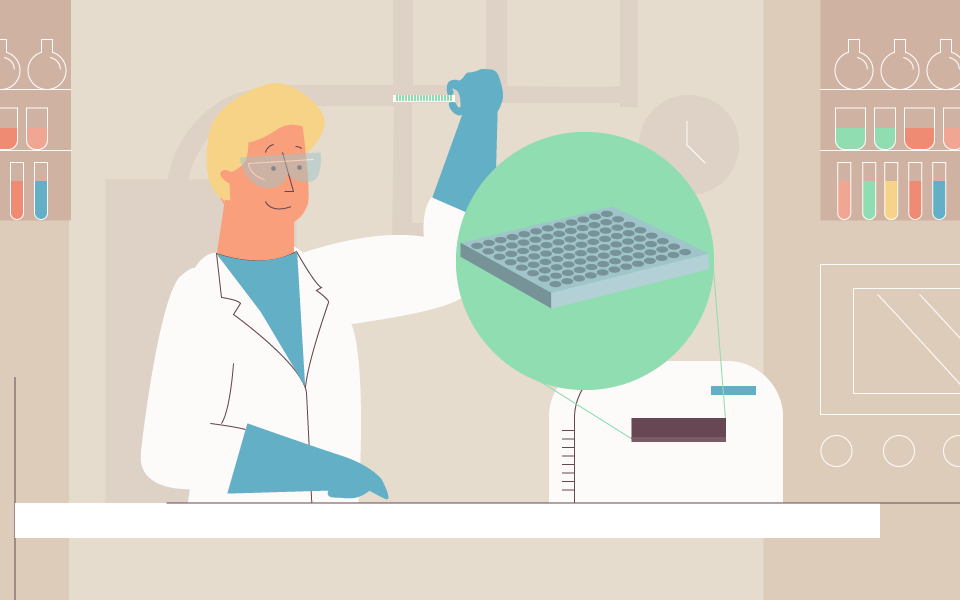
B. Hayes/NIST
As part of a government effort to reduce animal testing, researchers at the National Institute of Standards and Technology (NIST) have worked with the Consumer Product Safety Commission (CPSC) and Inotiv Inc. to produce a new protocol for screening skin allergens. The method is potentially cheaper and faster than animal testing, while maintaining a similar performance.
The researchers built upon on an existing method, improving its efficiency, accessibility and quality controls. Using the new animal-free protocol, they evaluated 92 chemicals and found that their results agreed with those of a common animal test method for 77% of the compounds. The results, published today in Toxics, increase confidence in the new method's measurements, potentially paving a route to standardization, which could both increase international trade and reduce animal testing.
Many governing bodies, including the European Union and certain U.S. states, have recently banned the sale of animal-tested cosmetics. However, animal testing is still required in some parts of the world to assess the safety of cosmetics. With regulations varying by region, it has become challenging for certain products to gain approval across the board.
Some animal-free methods of screening for skin allergens do exist, but their widespread adoption has been stymied by several limitations. For example, the direct peptide reactivity assay (DPRA) requires costly equipment that can only test a handful of samples at a time. The DPRA can be slow as well. To attain statistically meaningful conclusions about a test compound, testers would need to repeat the assay's multiday process multiple times.
The low sample size per test also reduces opportunity for control samples that would allow researchers to identify and minimize factors that may vary between samples and skew measurements.
To increase confidence in animal-free tests and promote their adoption, several federal agencies, coordinated by a standing committee of the National Institute of Environmental Health Sciences, are assessing the reliability of new, promising methods. The CPSC, a member agency of the committee, has partnered with NIST to evaluate a method much faster than the DPRA, known as the electrophilic allergen screening assay (EASA).
The EASA can be used to determine how reactive a chemical would be with human skin proteins, that is, how likely it would be to cause an allergic response. No actual proteins, or the amino acids they are made from, are present in the test. Instead, the researchers use two probe molecules, 4-nitrobenzenethiol (NBT) and pyridoxylamine (PDA), which, when reacting with other chemicals, undergo changes that can be detected optically.
"The two molecules are like surrogates for the amino acids cysteine and lysine," said Elijah Petersen, a NIST research scientist and lead author of the paper. "If a test compound binds to NBT and PDA, it is likely to also bind to the proteins in the skin, which is the first step of many adverse reactions."
Although the initial version of EASA showed promise, the NIST and CPSC researchers found it shared weaknesses with the DPRA, Petersen said. The type of instruments needed to run the original EASA method typically only hold up to eight samples at a time and are not readily available to most biological labs.
Petersen and colleagues reconfigured EASA so that 96 samples could be analyzed in a single run using plastic well plates and instruments called plate readers - two ubiquitous items in biological labs.
With up to 96 wells to work with, the researchers redesigned the protocol so that many control wells could be tested alongside wells containing test compounds. The controls would allow researchers to find out whether factors such as the solvent used, air bubbles in samples or the optical properties of the test compounds interfered with their measurements.
"In this one assay, we have much of the information we need to understand the sources of variability," Petersen said. "I think we really capture more and have more confidence compared to other methods."
To validate their redesigned protocol, the researchers used the new EASA to analyze 92 test compounds. Most of the chemicals had been assessed in previously published studies on mice through a standard test called the local lymph node assay (LLNA).
They found that the LLNA and EASA results agreed 77% of the time on which chemicals were allergens and which ones were not. Individual EASA tests were completed within a day, while LLNA tests require at least five days, Petersen said.
The new EASA also performed similarly to the DPRA, while testing samples at a higher rate and with more accessible equipment.
This work provides a robust methodology for evaluating the safety of cosmetics without animals. With further validation, the EASA could become a viable candidate for standardization and eventual adoption by regulatory bodies, according to Petersen.
"This study could support testing of commercial products, because we're going to have a really good method that's cheaper, faster, better quality," Petersen said. "I think it could also help raise the quality of in vitro test systems in general if people adopt our approach of adding extensive process controls."
Paper: Elijah Petersen, Richard Uhl, Blaza Toman, John Elliott, Judy Strickland, Jim Truax and John Gordon. Development of a 96-well electrophilic allergen screening assay for skin sensitization using a measurement science approach. Toxics. Published online May 17, 2022. DOI: 10.3390/toxics10050257






